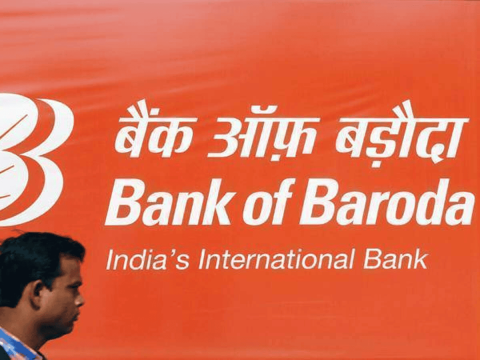Bank of Baroda Stock Price Could Reach Rs 275: Prabhudas Lilladher Research
Bank of Baroda’s Q4FY25 results revealed a mixed financial narrative—underwhelming interest income offset by resilient asset quality and an impressive boost in other income. Prabhudas Lilladher has reiterated a ‘Buy’ call on the public sector lender, albeit trimming the target price to Rs275 from Rs285, following a downward revision in NIM forecasts and earnings estimates. With a FY27E price-to-adjusted book value of 0.8x, the valuation remains appealing. While immediate margin compression continues to cloud sentiment, BoB’s strategic deposit rebalancing, corporate credit strength, and operational prudence offer medium-term clarity.
Muted Q4 NII Performance and Compressed Margins
Net Interest Income (NII) for Q4FY25 came in at Rs110.2 billion, missing estimates by 6%, as both loan yields and funding costs moved unfavorably. Calculated net interest margin (NIM) dropped 16bps year-over-year to 2.71%, reflecting a contraction in profitability amid rising deposit costs and a shift toward lower-yielding segments like housing and corporate loans.
Reported domestic NIM slid by 9bps QoQ to 2.94%, primarily due to a 13bps increase in deposit costs and an 11bps drop in lending yields. The bank expects margin compression to persist into Q1FY26, before recovering in the latter half as 20% of bulk deposits are due for repricing at lower rates.
Asset Quality Continues to Improve
Gross NPA declined by 17bps QoQ to 2.26%, while net NPA stood at 0.6%, with a robust coverage ratio of 74.9%. The bank’s guidance suggests no new stress formation in the MSME or corporate books, supported by improved collection efficiency and the adoption of cash flow-based credit monitoring tools.
Slippages remain under control, with legacy MSME accounts being systematically addressed. The write-off book stood at Rs600 billion, a third of which has already been recovered—highlighting meaningful traction in resolution efforts.
Other Income Delivers a Strong Beat
Non-interest income surged 52% above estimates to Rs52.1 billion, driven by healthy fee income, treasury gains, and recoveries from written-off accounts. This significantly cushioned the impact of lower NII, with PAT at Rs50.5 billion, beating estimates by over 24%.
Treasury income is expected to remain stable for FY26, while the bank continues to benefit from recoveries and improved fee-based income, particularly from retail and transaction banking.
Credit Growth Broad-Based Across Segments
Loan book expansion in Q4FY25 was 5.1% QoQ and 13.5% YoY, with robust traction across corporate (6.4%), retail (5.5%), agriculture (4.8%), and SME (3.5%) segments.
The growth strategy remains evenly spread, with the retail portfolio posting 19.4% YoY growth, supported by strong performance in home, auto, and personal loans. The bank has also set FY26 guidance of loan growth at 11–13% and deposit growth at 9–11%, subject to surplus liquidity conditions.
Operating Metrics Reflect Stable Efficiency
While cost pressures remain, operating expenses rose only 2.8% YoY. The cost-to-income ratio stood at 49.9%, a moderate increase of 61bps YoY. Operating profit grew 0.3% YoY to Rs81.3 billion, despite a 6.6% dip in NII, driven by the surge in other income.
Core PPoP (pre-provisioning operating profit) was down 7.3% YoY to Rs63.8 billion, but well-supported by treasury gains and lower-than-expected provisions.
Revised Forecasts Reflect Cautious Optimism
Following NIM compression, Prabhudas Lilladher has revised down earnings for FY26E and FY27E:
| Metric | FY26E | FY27E |
|---|---|---|
| NII (Rs m) | 4,83,584 | 5,51,589 |
| Operating Profit (Rs m) | 2,89,090 | 3,32,681 |
| PAT (Rs m) | 1,54,198 | 1,80,189 |
| EPS (Rs) | 29.8 | 34.8 |
| NIM (%) | 2.7 | 2.7 |
| RoAE (%) | 11.2 | 11.9 |
| RoAA (%) | 0.8 | 0.9 |
While these reflect a more conservative outlook, the long-term thesis remains intact due to normalization in funding costs, strength in credit underwriting, and resilience in asset quality.
Valuation Remains Attractive Despite Near-Term Pressure
The stock currently trades at 0.8x FY27E adjusted book value, offering valuation comfort relative to State Bank of India (SBI), which commands a premium multiple. With a dividend yield of 2.9% and ROAE projected to improve from 11.2% to 11.9% by FY27, the downside appears limited.
The revised target price of Rs275 (from Rs285) is based on a reduced multiple of 0.9x Mar’27 ABV, adjusted to reflect lower NIM trajectory.
Key Risks to Watch
Persistent Margin Pressure: Elevated deposit costs could continue into FY26 despite repricing initiatives.
Credit Growth Volatility: A sudden shift in macro conditions or regulatory lending norms may affect growth momentum.
Slower NPA Recovery: Delay in recoveries from large written-off accounts may weigh on other income.
Bottomline: A Tactical Hold, But a Strategic Buy
While Bank of Baroda’s near-term profitability is challenged by margin erosion and moderate earnings downgrades, its asset quality resilience, diversified loan growth, and improving operating leverage position it as a strategic long-term investment in India’s public sector banking space.
With management focused on margin repair, balance sheet optimization, and technology-led operational efficiency, investors with a 12–18 month horizon could benefit from price-to-book mean reversion and normalized profitability metrics.
